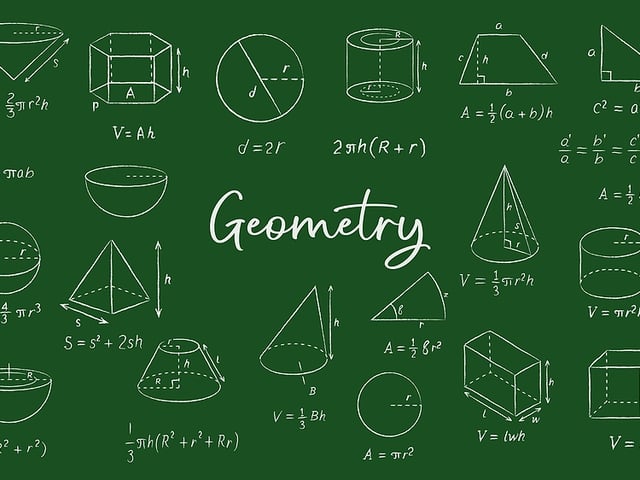
Geometry Formulas You Need to Know for the HiSET® Math Test
The HiSET® test is so straightforward that it gives you a formula chart to use during the test Here at Union Test Prep, we have a sneak peek of what you’ll see on that formula chart, but you’ll probably need a little extra assistance, as well. There are more equations applicable in this test than the ones on the “official” formula chart you’ll be given during the test. So, in the following chart, you’ll find the Geometry formulas that won’t be given to you but that you need to know for the HiSET® Math Test.
We also have two other charts of formulas that are not given to you during the test and a preview of the chart of formulas you will be given during the HiSET Math Test session.
Algebra Formulas You Need to Know for the HiSET® Math Test
Statistics and Probability Formulas You Need to Know for the HiSET® Math Test
Formulas You Will Be Given for the HiSET® Math Test
Geometry Formulas for the HiSET® Math Test
| Category | Formula | Symbols | Comment |
|---|---|---|---|
| Triangles | \(P=s_1+s_2+s_3\) | \(P\) = Perimeter of a triangle \(s_n\) = side length |
|
| Triangles | \(A = \frac{1}{2} \cdot b \cdot h\) | \(A\) = Area of a triangle \(b\) = base \(h\) = height |
|
| Triangles | \(\Sigma \theta = 180^\circ\) | \(\Sigma \theta\) = Sum of the interior angles | |
| Triangles | \(a^2 + b^2 = c^2\) | \(a, \ b\) = Legs of a right triangle \(c\) = Hypotenuse of a right triangle |
Pythagorean Theorem |
| Quadrilaterals | \(P = 4 \cdot s\) | \(P\) = Perimeter of a square \(s\) = Side length |
|
| Quadrilaterals | \(P = 2 \cdot l + 2 \cdot w\) | \(P\) = Perimeter of a rectangle \(l\) = Length \(w\) = width |
|
| Quadrilaterals | \(A=s^2\) | \(A\) = Area of a square \(s\) = Side length |
|
| Quadrilaterals | \(A = l \cdot w\) | \(A\) = Area of a rectangle \(l\) = Length \(w\) = Width |
|
| Quadrilaterals | \(A = h \cdot \dfrac{b_1+b_2}{2}\) | \(A\) = Area of a trapezoid \(h\) = Height \(b_n\) = Base \(n\) |
|
| Quadrilaterals | \(\Sigma \theta = 360^\circ\) | \(\Sigma \theta\) = Sum of the interior angles | |
| Regular Polygons | \(\Sigma \theta = 180^\circ \cdot (n-2)\) | \(\Sigma \theta\) = Sum of the interior angles \(n\) = Number of sides |
|
| Regular Polygons | \(\theta = \dfrac{180 \cdot (n-2)}{n}\) | \(\theta\) = Interior angle measure \(n\) = Number of sides |
|
| Circles | \((x-h)^2 + (y-k)^2 = r^2\) | \((h,k)\) = Center of a circle \(r\) = Radius |
Standard form of a circle |
| Circles | \(C=2 \cdot \pi \cdot r = \pi \cdot d\) | \(C\) = Circumference (perimeter) of a circle \(r\) = radius \(d\) = diameter \(\pi\) = 3.14 |
|
| Circles | \(S = r \cdot \theta\) | \(S\) = Arc length \(r\) = Radius \(\theta\) = Central angle (in radians) |
|
| Circles | \(A= \pi \cdot r^2\) | \(A\) = Area of a circle \(\pi\) = 3.14 \(r\) = Radius |
|
| Transformations | \((x, y) \rightarrow (x, -y)\) | Reflection x-axis | |
| Transformations | \((x, y) \rightarrow (-x, y)\) | Reflection y-axis | |
| Transformations | \((x, y) \rightarrow (-x, -y)\) | Reflection origin | |
| Transformations | \((x, y) \rightarrow (y, x)\) | Reflection Line \(y=x\) | |
| Transformations | \((x, y) \rightarrow (-y, -x)\) | Reflection Line \(y=-x\) | |
| Transformations | \((x, y) \rightarrow (y, -x)\) | Rotation \(90^\circ\) Counterclockwise | Rotation around the origin |
| Transformations | \((x, y) \rightarrow (-x, -y)\) | Rotation \(180^\circ\) Counterclockwise | Rotation around the origin |
| Transformations | \((x, y) \rightarrow (x+a, y+b)\) | Translation | |
| Transformations | \((x, y) \rightarrow (rx, ry)\) | Dilation \(r\) = Scale factor | |
| 3-Dimensional Objects | \(V= l \cdot w \cdot h\) | \(V\) = Volume of a rectangular prism \(l\) = Length \(w\) = Width \(h\) = Height |
|
| 3-Dimensional Objects | \(SA = \Sigma A_{fi}\) | \(SA\) = Surface area of a prism \(A_{fi}\) = Area of face \(i\) |
|
| 3-Dimensional Objects | \(V=\frac{1}{3} \cdot (l \cdot w \cdot h)\) | \(V\) = Volume of a pyramid \(l\) = Length \(w\) = Width \(h\) = height |
|
| 3-Dimensional Objects | \(SA = \Sigma A_{fi}\) | \(SA\) = Surface area of a pyramid \(A_{fi}\) = Area of face \(i\) |
|
| 3-Dimensional Objects | \(V= \pi \cdot r^2 \cdot h\) | \(V\) = Volume of a cylinder \(r\) = Radius \(h\) = Height |
|
| 3-Dimensional Objects | \(SA = 2B +(C \cdot h)\) | \(SA\) = Surface area of a cylinder \(B\) = Area of base \(C\) = Circumference of base \(h\) = Height |
|
| 3-Dimensional Objects | \(V = \frac{4}{3} \cdot \pi \cdot r^3\) | \(V\) = Volume of a sphere \(r\) = Radius |
|
| 3-Dimensional Objects | \(SA = 4 \cdot \pi \cdot r^2\) | \(SA\) = Surface area of a sphere \(r\) = Radius |
|
| Density | \(\rho = \dfrac{m}{v}\) | \(\rho\) = Density \(m\) = Mass \(v\) = Volume |

HiSET Test Blog
Must-Know Science Formulas for the HiSET Test
Achieving proficiency in science can be challenging. If you’re studying…

HiSET Test Blog
Is the HiSET Easier Than the GED?
Over 2 million 16-24-year-olds in the U.S. lack a high school education…

HiSET Test Blog
The HiSET vs the GED: What’s the Difference?
There are several exams that can be taken as an alternative to receivin…